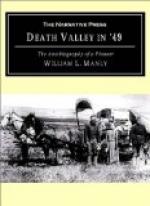We staid all night here and dug around in some other places in the bottom of the canon, in the hope to have better luck than they did, but we got no water anywhere.
We seemed almost perishing for want of water, the hard exercise made us perspire so freely. In the morning we started on, and near the summit we came to the dead body of Mr. Fish, laying in the hot sun, as there was no material near here with which his friends could cover the remains. This Mr. Fish was the man who left camp some two weeks before in company with another and who carried the long whiplash wound about his body, in hope he could somewhere be able to trade it for bread. No doubt in this very place where he breathed his last, his bones still lie.
As we came in sight of the next valley, we could see a lake of water some distance south of our western course.
We had followed the Jayhawkers trail thus far, but as we found no water in small holes in the rocks as we were likely to do when we were the first to pass, we decided to take a new route in the hope to find a little water in this way, for we had no hope of finding it in any other. This valley we now crossed seemed to come to an end about ten miles to the north of us. To the south it widened out, enclosing the lake spoken of. This valley was very sandy and hard to walk over. When about halfway across we saw some ox tracks leading toward the lake, and in the hope we might find the water drinkable we turned off at right angles to our course and went that way also. Long before we reached the water of the lake, the bottom became a thin, slimy mud which was very hard on our mocassins. When we reached the water we found it to be of a wine color, and so strongly alkaline as to feel slippery to the touch, and under our feet.
This side trip, had cost us much exertion and made us feel more thirsty than ever.
We turned now west again, making for a canon, up which we passed in the hope we should at some turn find a little basin of rain water in some rock. We traveled in it miles and miles, and our mouths became so dry we had to put a bullet or a small smooth stone in and chew it and turn it around with the tongue to induce a flow of saliva. If we saw a spear of green grass on the north side of a rock, it was quickly pulled and eaten to obtain the little moisture it contained.
Thus we traveled along for hours, never speaking, for we found it much better for our thirst to keep our mouths closed as much as possible, and prevent the evaporation. The dry air of that region took up water as a sponge does. We passed the summit of this ridge without finding any water, and on our way down the western side we came to a flat place where there was an Indian hut made of small brush. We now thought there surely must be some water near and we began a thorough search. The great snow mountain did not seem far off, but to the south and southwest a level or inclined plain extended for a long distance. Our thirst began to be something terrible to endure, and in the warm weather and hard walking we had secured only two drinks since leaving camp.




